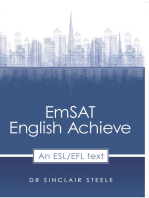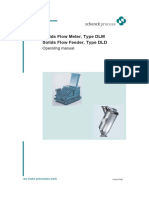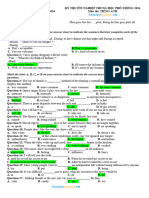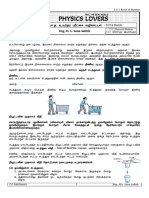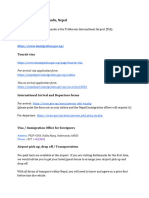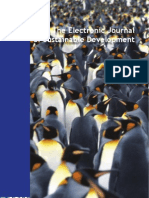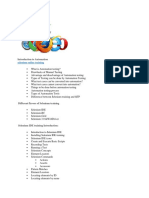Đề 2
Đề 2
Uploaded by
lacnhud9123Copyright:
Available Formats
Đề 2
Đề 2
Uploaded by
lacnhud9123Original Title
Copyright
Available Formats
Share this document
Did you find this document useful?
Is this content inappropriate?
Copyright:
Available Formats
Đề 2
Đề 2
Uploaded by
lacnhud9123Copyright:
Available Formats
English.with.ms.
An
English.with.msAn ĐỀ THI THỬ THPT QUỐC GIA SỐ 2
Môn thi: Tiếng Anh
Biên Soạn: Ms An
Thời gian làm bài: 60 phút (không kể thời gian phát đề)
Mark the letter A, B, C, or D on your answer sheet to indicate the word whose underlined part differs from the
other three in pronunciation in each of the following questions
Question 1: A. performed B. impaired C. designed D. produced
Question 2: A. substantial B. initiate C. participant D. attention
Mark the letter A, B, C, or D on your answer sheet to indicate the word that differs from the rest in the position
of the main stress in each of the following questions.
Question 3. A. Company B. Atmosphere C. Customer D. Employment
Question 4. A. contain B. purchase C. reflect D. suggest
Mark the letter A, B, C, or D on your answer sheet to indicate the underlined part that needs correction in each
of the following questions.
Question 5: We have conducted (A) exhausting research (B) into the effects of smartphones on students’ (C)
behaviour and their (D) academic performance.
Question 6: (A) On the table (B) is (C) hundreds of books written (D) in English.
Question 7: Tim works (A) as a doctor and he (B) earns (C) twice (D) as much than his brother.
Mark the letter A, B, C, or D on your answer sheet to indicate the sentence that best completes each of the
following exchanges.
Question 8: Kelly: “It’s was very kind of you to give me a lift home”. - Mark: “_________ ”
A. As a matter of fact, you’re pretty nice.
B. Oh, don’t do that. I was coming past your house any way.
C. I’m not pleased.
D. Oh, don’t mention it. I was coming past your house any way.
Question 9: Two students are talking about the school curriculum.
- Hoa: “Swimming should be taught in the school.” - Nam: “ _________ .It is an essential life skill.”
A. Oh, that’s a problem B. I can’t agree with you more
C. Not at all D. You can make it
Mark the letter A, B, C, or D on your answer sheet to indicate the correct answer to each of the following
questions.
Question 10: This girl doesn’t reveal much about herself, and is .............................fascinating for it.
A. as B. the same C. all the more D. the more
Question 11: Many parents tend to push their children because they believe that good education will enable them
to _________ in the future.
A. turn up B. get on C. get out D. turn down
Question 12: It gets _________ when the winter is coming.
A. cold and cold B. cold and colder C. more and more cold D. colder and colder
Question 13: The organization underwent _________ reforms.
A. far-reaching B. far-gone C. far-off D. far-flung
Question 14: The Beauty Contest is _________start at 8:00 a.m our time next Monday.
A. due to B. bound to C. about to D. on the point of
Question 15: If people paid more attention to the environment, the Earth _________ greener.
A. would be B. will be C. would have been D. had been
Question 16: Nobody comes there, _________ ?
A. does he B. doesn’t he C. do they D. don’t they
Question 17: The teacher likes her essay because it’s very ....................................... .
A. imagination B. imaginable C. imaginative D. imaginary
Question 18: I have lived in this city for so long, so I’ve grown ............................to the noise of vehicles.
A. accustomed B. unconscious C. familiar D. aware
Question 19: All applicants must .......................a full CV with their job application before October . st 1
A. permit B. omit C. submit D. admit
Question 20: That book is about the people in Samoa ........................................ for two years.
A. that she lived B. that she lived among them
English.with.ms.An Call me for help 0982220296
English.with.ms.An
C. among whom she lived D. where she lived among them
Question 21: When the first child was born, they .................................... married for three years.
A. have been married B. had been married
C. will been married D. will have been married
Mark the letter A, B, C, or D on your answer sheet to indicate the word(s) CLOSEST in meaning to the
underlined word(s) in each of the following questions
Question 22: Polio is one of the top ten incurable diseases that modern medicine has failed to eradicate.
A. disabling B. vexatious C. dangerous D. irreparable
Question 23: The new cartoon film catches the fancy of the children.
A. satisfies B. amuses C. attracts D. surprises
Mark the letter A, B, C, or D on your answer sheet to indicate the word(s) OPPOSITE in meaning to the
underlined word(s) in each of the following questions.
Question 24: The change in population distribution was barely noticeable to the demographers conducting the study.
A. often B. hardly C. never D. softly
Question 25: Sally has just won a full scholarship to one of the most prestigious universities in the world; she
must be on cloud nine now.
A. extremely panicked B. obviously delighted C. incredibly optimistic D. desperately sad
Mark the letter A, B, C, or D on your answer sheet to indicate the sentence that is closest in meaning to each of
the following questions.
Question 26: French is the only language other than English spoken on five continents.
A. French and English are the only languages that are spoken on five continents.
B. Unlike French, English is spoken on five continents.
C. French and English are spoken widely in official and commercial circles.
D. Before English, French was the only language spoken on five continents.
Question 27: “Don’t forget to submit your assignments by Friday,” said the teacher to the students.
A. The teacher reminded the students to submit their assignments by Friday.
B. The teacher allowed the students to submit their assignments by Friday.
C. The teacher ordered the students to submit their assignments by Friday.
D. The teacher encouraged the students to submit their assignments by Friday.
Question 28: He didn’t eat anything but small pieces of bread and butter.
A. He ate small pieces of bread and butter but didn’t like them.
B. He only ate some small pieces of bread and butter.
C. He didn’t eat anything, not even the bread and butter.
D. He didn’t touch the bread and butter, but he ate other things.
Mark the letter A, B, C, or D on your answer sheet to indicate the sentence that best combines each pair of
sentences in the following questions
Question 29: He helped us a lot with the project. We couldn’t continue without him.
A. Provided his contribution wouldn’t come, we couldn’t continue with the project.
B. But for his contribution, we could have continued with the project.
C. Unless we had his contribution, we could continue with the project.
D. If he hadn’t contributed positively, we couldn’t have continued with the project.
Question 30: The storm was so great. Many families had to be evacuated to safer parts of the city.
A. Although the storm was not great, many families had to be evacuated to safer parts of the city.
B. So great was the storm that many families had to be evacuated to safer parts of the city.
C. Many families had to be evacuated to safer parts of the city in spite of the great storm.
D. It was so a great storm that many families had to be evacuated to safer parts of the city.
Read the following passage and mark the letter A, B, C, or D on your answer sheet to indicate the correct word or
phrase that best fits each of the numbered blanks from 31 to 35.
The use of computers has meant that students can study language programmes (31) _________ their own speed when
and for how long they want. What’s more, in the virtual classrooms of the future the student will put on their headset,
and be transported into an imaginary school, choose their class, take the books they need off the shelf and hold
conversations with other computerised students. They might instead choose to pay a visit to the supermarket or the
train station, the bank or the restaurant. At the (32) _________ of a button they would be transported to (33)
_________ realistic settings where they could practice their English, maybe getting a hand from a virtual English
companion. All this perhaps, at the computer, from the comfort of their home: no (34) _________to catch the bus to
college, or a plane to England. Exciting? Certainly, and it’s an interesting alternative to traditional classroom lessons.
English.with.ms.An Call me for help 0982220296
English.with.ms.An
But would it ever (35)_________the classroom? Hopefully not. Surely the need to relate to real people talking about
real issues and generally learning a little more about others will always lead language learners to uzcx be exc eg at
least a little of their time with real people.
Question 31: A. on B. in C. at D. of
Question 32: A. force B. hit C. depress D. push
Question 33: A. so B. such C. like D. alike
Question 34: A. role B. duty C. obligation D. need
Question 35: A. replace B. restore C. succeed D. recover.
Read the following passage and mark the letter A, B, C, or D on your answer sheet to indicate the correct
answer to each of the questions from 36 to 42
Some animal behaviorists argue that certain animals can remember past events, anticipate future ones,
make plans and choices, and coordinate activities within a group. These scientists, however, are cautious about
the extent to which animals can be credited with conscious processing.
Explanations of animal behavior that leave out any sort of consciousness at all and ascribe actions entirely
to instinct leave many questions unanswered. One example of such unexplained behavior: Honeybees
communicate the sources of nectar to one another by doing a dance in a figure-eight pattern. The orientation of the
dance conveys the position of the food relative to the sun’s position in the sky, and the speed of the dance tells
how far the food source is from the hive. Most researchers assume that the ability to perform and encode the
dance is innate and shows no special intelligence. But in one study, when experimenters kept changing the site of
the food source, each time moving the food 25 percent farther from the previous site, foraging honeybees began to
anticipate where the food source would appear next. When the researchers arrived at the new location, they would
find the bees circling the spot, waiting for their food. No one has yet explained how bees, whose brains weigh four
ten-thousandths of an ounce, could have inferred the location of the new site.
Other behaviors that may indicate some cognition include tool use. Many animals, like the otter who uses
a stone to crack mussel shells, are capable of using objects in the natural environment as rudimentary tools. One
researcher has found that mother chimpanzees occasionally show their young how to use tools to open hard nuts.
In one study, chimpanzees compared two pairs of food wells containing chocolate chips. Allowed to choose
which pair they wanted, the chimpanzees almost always chose the one with the higher total, showing some sort of
summing ability. Other chimpanzees have learned to use numerals to label quantities of items and do simple
sums.
Question 36: What does the passage mainly discuss?
A. The role of instinct in animal behavior
B. Observations that suggest consciousness in animal behavior
C. The use of food in studies of animal behavior
D. Differences between the behavior of animals in their natural environments and in laboratory experiments.
Question 37: Which of the following is NOT discussed as an ability animals are thought to have?
A. Selecting among choices B. Anticipating events to come
C. Remembering past experiences D. Communicating emotions
Question 38: What is the purpose of the honeybee dance?
A. To determine the quantity of food at a site
B. To communicate the location of food
C. To increase the speed of travel to food sources
D. To identify the type of nectar that is available
Question 39: The word “yet” in line 15 is closest in meaning to
A. however B. since C. generally D. so far
Question 40: It can be inferred from the passage that brain size is assumed to _________.
A. be an indicator of cognitive ability B. vary among individuals within a species
C. be related to food consumption D. correspond to levels of activity
Question 41: Why are otters and mussel shells included in the discussion in paragraph 3?
A. To provide that certain species demonstrate greater ability in tool use than other species.
B. To provide an example of tool use among animals.
C. To show that animals are very good at using objects in their habitat.
D. To provide an example of the use of weapons among animals.
Question 42: The phrase “the one” in paragraph 3 refers to the _________ .
A. study B. pair C. chimpanzee D. ability
English.with.ms.An Call me for help 0982220296
English.with.ms.An
Read the following passage and mark the letter A, B, C, or D on your answer sheet to indicate the correct
answer to each of the questions from 43 to 50.
The Native American peoples of the north Pacific Coast created a highly complex maritime culture as
they invented modes of production unique to their special environment. In addition to their sophisticated
technical culture, they also attained one of the most complex social organizations of any nonagricultural people in
the world.
In a division of labor similar to that of the hunting peoples in the interior and among foraging peoples
throughout the world, the men did most of the fishing, and the women processed the catch. Women also
specialized in the gathering of the abundant shellfish that lived closer to shore. They collected oysters, crabs, sea
urchins, abalone, and clams, which they could gather while remaining close to their children. The maritime life
harvested by the women not only provided food, but also supplied more of the raw materials for making tools
than did fish gathered by the men. Of particular importance for the native tool than did the fish gathered by the
men. Of particular made from the larger mussel shells, and a variety of cutting edges that could be made from
other marine shells.
The women used their tools to process all of the fish and marine mammals brought in by the men. They
cleaned the fish, and dried vast quantities of them for the winter. They sun - dried fish when practical, but in the
rainy climate of the coastal area they also used smokehouses to preserve tons of fish and other seafood annually.
Each product had its own peculiar characteristics that demanded a particular way of cutting or drying the meat,
and each task required its own cutting blades and other utensils.
After drying the fish, the women pounded some of them into fish meal, which was an easily transported
food used in soups, stews, or other dishes to provide protein and thickening in the absence of fresh fish or while
on long trips. The women also made a cheese-like substance from a mixture of fish and roe by aging it in
storehouses or by burying it in wooden boxes or pits lined with rocks and tree leaves.
Question 43: Which aspect of the lives of the Native Americans of the north Pacific Coast does the passage
mainly discuss?
A. Methods of food preservation B. How diet was restricted by the environment
C. The contributions of women to the food supply D. Difficulties in establishing successful farms
Question 44: The word “unique” in the first paragraph is closest in meaning to _________.
A. comprehensible B. productive C. intentional D. particular
Question 45: It can be inferred from paragraph 1 that the social organization of many agricultural peoples is
_________ .
A. more complex than that of hunters and foragers B. less efficient than that of hunters and foragers
C. more widespread than that of hunters and foragers D. better documented than that of hunters and foragers
Question 46: According to the passage, what is true of the “division of labor” mentioned in paragraph 2?
A. It was first developed by Native Americans of the north Pacific Coast.
B. It rarely existed among hunting
C. It was a structure that the Native Americans of the north Pacific Coast shared with many other peoples.
D. It provided a form of social organization that was found mainly among coastal peoples.
Question 47: All of the following are true of the north Pacific coast women EXCEPT that they ______
A. were more likely to catch shellfish than other kinds of fish
B. contributed more materials for tool making than the men did
C. sometimes searched for food far inland from the coast
D. prepared and preserved the fish
Question 48. The word “They” in paragraph 3 refers to _________ .
A. women B. tools C. mammals D. men
Question 49. The Native Americans of the north Pacific Coast used smokehouses in order to _________ .
A. store utensils used in food preparation B. prevent fish and shellfish from spoiling
C. have a place to store fish and shellfish D. prepare elaborate meals
Question 50. All of following are true of the cheese-like substance mentioned in paragraph 4 EXCEPT that it was
_________ .
A. made from fish B. not actually cheese
C. useful on long journeys D. made in a short period of time
English.with.ms.An Call me for help 0982220296
You might also like
- Bleckmann Roman War Finances in The Age of The Punic WarsDocument9 pagesBleckmann Roman War Finances in The Age of The Punic WarsMiddle Republican HistorianNo ratings yet
- Solids Flow Meter, Type DLM Solids Flow Feeder, Type DLD: Operating ManualDocument20 pagesSolids Flow Meter, Type DLM Solids Flow Feeder, Type DLD: Operating ManualArturMirandaNo ratings yet
- (Đề kiểm tra có 03 trang) Thời gian: 50 phútDocument4 pages(Đề kiểm tra có 03 trang) Thời gian: 50 phútngocha23112004No ratings yet
- Thời gian làm bài: (60) phút; (không kể thời gian giao đề)Document9 pagesThời gian làm bài: (60) phút; (không kể thời gian giao đề)Võ ToạiNo ratings yet
- 10. Đề thi thử TN THPT năm 2022 - Sở giáo dục Tuyên QuangDocument7 pages10. Đề thi thử TN THPT năm 2022 - Sở giáo dục Tuyên Quangroseannepark2912No ratings yet
- (123doc) de Thi Thu THPTQG 2019 Tieng Anh THPT Chuyen Vinh Phuc Lan 3 Co Loi GiaiDocument18 pages(123doc) de Thi Thu THPTQG 2019 Tieng Anh THPT Chuyen Vinh Phuc Lan 3 Co Loi GiaiHà LêNo ratings yet
- De Thi Thu Vao Lop 10 THPT Mon Tieng Anh Nam 2020Document6 pagesDe Thi Thu Vao Lop 10 THPT Mon Tieng Anh Nam 2020congnhat2010No ratings yet
- Đề Dự Đoán Số 5-Ngày 09062023-Khóa Cấp Tốc 2k5 Biên Soạn Cô Phạm LiễuDocument7 pagesĐề Dự Đoán Số 5-Ngày 09062023-Khóa Cấp Tốc 2k5 Biên Soạn Cô Phạm Liễungoclinh14112005bnNo ratings yet
- 17.MH 17-2021-File Word Có Lời Giải Chi TiếtDocument14 pages17.MH 17-2021-File Word Có Lời Giải Chi Tiếtlan nguyenNo ratings yet
- De Tthu So 1 Thang 4Document12 pagesDe Tthu So 1 Thang 4Vi HuynhNo ratings yet
- QG - THPT My Duc B 2Document5 pagesQG - THPT My Duc B 2De MingmingNo ratings yet
- De Thi Hk1 Tieng Anh 12 Nam 2019 2020 Truong THPT Phan Dinh Phung Ha TinhDocument7 pagesDe Thi Hk1 Tieng Anh 12 Nam 2019 2020 Truong THPT Phan Dinh Phung Ha TinhThủy NguyễnNo ratings yet
- Trường THPT Cẩm KhêDocument4 pagesTrường THPT Cẩm Khê04 Nguyễn Ngọc ÁnhNo ratings yet
- HQV - Đề AnhDocument12 pagesHQV - Đề AnhTrang TrầnNo ratings yet
- ĐỀ 9Document12 pagesĐỀ 9hungtuhuyhangNo ratings yet
- 62. Đề thi thử TN THPT 2021 - Môn Tiếng anh - Sở GD&ĐT Thanh Hóa - File word có lời giảiDocument19 pages62. Đề thi thử TN THPT 2021 - Môn Tiếng anh - Sở GD&ĐT Thanh Hóa - File word có lời giảiThinh LeNo ratings yet
- Đề Thi Thử TS10-TAnh-TP-22-23-Mã 901Document5 pagesĐề Thi Thử TS10-TAnh-TP-22-23-Mã 901Doãn KhánhNo ratings yet
- Thời gian làm bài: 60 phút, không kể thời gian phát đềDocument16 pagesThời gian làm bài: 60 phút, không kể thời gian phát đềKhánh VânNo ratings yet
- đề thi thử đh tiếng anh 1Document10 pagesđề thi thử đh tiếng anh 1SedeaNo ratings yet
- Thu Anh 896Document5 pagesThu Anh 896Linh MaiNo ratings yet
- Truong Chu Van An - QT L2Document6 pagesTruong Chu Van An - QT L2vietyini2No ratings yet
- Key Test 17 - 18Document7 pagesKey Test 17 - 1824. Võ Nguyễn Ngọc NhiNo ratings yet
- THPT Chân MộngDocument10 pagesTHPT Chân Mộng04 Nguyễn Ngọc ÁnhNo ratings yet
- QG - THPT Ngoc Hoi 2Document5 pagesQG - THPT Ngoc Hoi 2De MingmingNo ratings yet
- Môn Tiếng Anh: Trang 1/5 - ĐỀ SỐ 12Document5 pagesMôn Tiếng Anh: Trang 1/5 - ĐỀ SỐ 12kimlamtranNo ratings yet
- De 10 Nhom 3 64086Document5 pagesDe 10 Nhom 3 64086nochu940No ratings yet
- (G12) ĐỀ 11-14Document20 pages(G12) ĐỀ 11-14Lien NguyenNo ratings yet
- Mock Test 119Document4 pagesMock Test 119Ngan Nguyen PhuongNo ratings yet
- Thời gian làm bài: 60 phút, không kể thời gian phát đề: A. B. C. DDocument19 pagesThời gian làm bài: 60 phút, không kể thời gian phát đề: A. B. C. Dgb phạmNo ratings yet
- ĐỀ MINH HỌA 2023 HÀ TĨNHDocument53 pagesĐỀ MINH HỌA 2023 HÀ TĨNHTuyếtNhungNguyễnNo ratings yet
- ĐÁP ÁN ĐỀ VIP 19 - chuỗi (vip10)Document18 pagesĐÁP ÁN ĐỀ VIP 19 - chuỗi (vip10)27. Lê Nhân QuânNo ratings yet
- 20. Đề Thi Thử TN THPT 2021 - Môn Tiếng Anh - Penbook - Đề Số 20 - File Word Có Lời GiảiDocument23 pages20. Đề Thi Thử TN THPT 2021 - Môn Tiếng Anh - Penbook - Đề Số 20 - File Word Có Lời GiảiHuong NguyenNo ratings yet
- De Thi Hoc Ki 2 Mon Tieng Anh Lop 12 de 3Document4 pagesDe Thi Hoc Ki 2 Mon Tieng Anh Lop 12 de 3hai ngoNo ratings yet
- ĐỀ CHUẨN MINH HỌA SỐ 14 21Document34 pagesĐỀ CHUẨN MINH HỌA SỐ 14 21hapham.31211025961No ratings yet
- ĐỀ KS K10 LẦN 4 - ĐỀ SỐ 1Document6 pagesĐỀ KS K10 LẦN 4 - ĐỀ SỐ 1Hòa VũNo ratings yet
- Nguyen Tat ThanhDocument5 pagesNguyen Tat ThanhNgọc TrầnNo ratings yet
- 11b11- đề 16Document4 pages11b11- đề 16Phạm Hồng NhungNo ratings yet
- MH 07 2021 File WordDocument4 pagesMH 07 2021 File WordHoài VŨNo ratings yet
- De Thi Chon HSGDocument102 pagesDe Thi Chon HSGDương Hà MinhNo ratings yet
- ĐỀ SỐ 01- ĐỀ DƯ ÁN 2024- THẢODocument4 pagesĐỀ SỐ 01- ĐỀ DƯ ÁN 2024- THẢOdo thaoNo ratings yet
- De Thi THPT Quoc Gia 2023 Mon Anh Ma de 403Document5 pagesDe Thi THPT Quoc Gia 2023 Mon Anh Ma de 403linniepham20499No ratings yet
- Assessment Test 2Document4 pagesAssessment Test 2lovebtslovejk29No ratings yet
- Ma de 101Document4 pagesMa de 101Quynh NguyenNo ratings yet
- Đề Số 14Document5 pagesĐề Số 14Yến Hải LạiNo ratings yet
- (ThichTiengAnh.Com) Đề 002 - PRO SAT 2017 PDFDocument12 pages(ThichTiengAnh.Com) Đề 002 - PRO SAT 2017 PDFNguyen Hiep DuyNo ratings yet
- 00. Đề minh họa lần 2 của BGD - ĐTDocument7 pages00. Đề minh họa lần 2 của BGD - ĐTTrần DiễmNo ratings yet
- Mark The Letter A, B, C, or D On Your Answer Sheet To Indicate The Correct Answer To Each of The Following QuestionsDocument6 pagesMark The Letter A, B, C, or D On Your Answer Sheet To Indicate The Correct Answer To Each of The Following Questionsthu nguyenNo ratings yet
- (GD2023) de Thi Thu TN THPT Nam 2023 Mon Tieng Anh So Giao Duc Va Dao Tao Tinh Phu Tho Lan 2 10136744 626202315210PMDocument8 pages(GD2023) de Thi Thu TN THPT Nam 2023 Mon Tieng Anh So Giao Duc Va Dao Tao Tinh Phu Tho Lan 2 10136744 626202315210PMnthutrang791No ratings yet
- De Dap An Bai Thi Thu TNPT 2017 Bai So 10Document36 pagesDe Dap An Bai Thi Thu TNPT 2017 Bai So 10hang my NguyenNo ratings yet
- Ubnd Quận Long BiênDocument6 pagesUbnd Quận Long BiênThanh Trúc TrầnNo ratings yet
- Đề 8.Mh2022.Key Chi TiếtDocument19 pagesĐề 8.Mh2022.Key Chi Tiếttailieu hienNo ratings yet
- LOP 12A4 1.2 de Thi Thu 2023 (03) - Hòn ĐấtDocument4 pagesLOP 12A4 1.2 de Thi Thu 2023 (03) - Hòn Đấtkhangduong.31231024831No ratings yet
- Đề thi thử HK2 3Document5 pagesĐề thi thử HK2 3Trương Phạm Kim LongNo ratings yet
- 10 đề tiếng anhDocument53 pages10 đề tiếng anhfamlinhNo ratings yet
- THPTQG Anh 2022 - tỉnh Bạc LiêuDocument5 pagesTHPTQG Anh 2022 - tỉnh Bạc LiêuVan A NguyenNo ratings yet
- Đề 7. Đề Thi Thử TN THPT Môn Tiếng Anh Theo Cấu Trúc Đề Minh Họa 2021 - Cô Oanh 7 - Có Lời GiảiDocument17 pagesĐề 7. Đề Thi Thử TN THPT Môn Tiếng Anh Theo Cấu Trúc Đề Minh Họa 2021 - Cô Oanh 7 - Có Lời GiảiIm Đi ChịNo ratings yet
- Đề 7.Document17 pagesĐề 7.Anh Thái ĐoànNo ratings yet
- Sở Gd-Đt Lâm Đồng Đề Minh Họa Kỳ Thi Trung Học Phổ Thông Quốc Gia Năm 2017 Môn: Tiếng AnhDocument6 pagesSở Gd-Đt Lâm Đồng Đề Minh Họa Kỳ Thi Trung Học Phổ Thông Quốc Gia Năm 2017 Môn: Tiếng AnhkimlamtranNo ratings yet
- Đề 7. (7) 2Document17 pagesĐề 7. (7) 2Anh Thái ĐoànNo ratings yet
- Đề số 9Document6 pagesĐề số 9anhnguyet31082006No ratings yet
- Đề Tham Khảo Đề Số 16 Kỳ Thi Trung Học Phổ Thông Quốc Gia Năm 2017 Môn: Tiếng AnhDocument5 pagesĐề Tham Khảo Đề Số 16 Kỳ Thi Trung Học Phổ Thông Quốc Gia Năm 2017 Môn: Tiếng AnhkimlamtranNo ratings yet
- Mongols Mini DBQDocument4 pagesMongols Mini DBQasdasiodasodNo ratings yet
- Capstone Proposal Final Like Medj FinalDocument22 pagesCapstone Proposal Final Like Medj FinalCABABAN, SHAIRA A. STEM2No ratings yet
- AAIR BOA - Complete File - November 23Document54 pagesAAIR BOA - Complete File - November 23Rex LimNo ratings yet
- TURBO 1 - 2012 - GTs-rev.A PDFDocument140 pagesTURBO 1 - 2012 - GTs-rev.A PDFAshraf AbdelrahmanNo ratings yet
- Citizen Journalism WorkshopDocument2 pagesCitizen Journalism WorkshopNezam MarandaNo ratings yet
- Perubahan Sosial Masyarakat Nelayan Di Desa Cupel Kecamatan Negara Kabupaten JembranaDocument12 pagesPerubahan Sosial Masyarakat Nelayan Di Desa Cupel Kecamatan Negara Kabupaten Jembrana36Muhammad Rizal AfnaniNo ratings yet
- SxsDocument12 pagesSxsArvin BabuNo ratings yet
- TC4013Document3 pagesTC4013J. AguilarNo ratings yet
- 2.3.1.newtons LawDocument18 pages2.3.1.newtons LawdigitalimagentrNo ratings yet
- Communication InterfaceDocument10 pagesCommunication InterfaceHarini MNo ratings yet
- Moc U Medjunarodnim Odnosima - 09 - 10Document103 pagesMoc U Medjunarodnim Odnosima - 09 - 10Nedeljkovic Ex Nikolic AnaNo ratings yet
- Sample Question Paper: General Knowledge and Current AffairsDocument4 pagesSample Question Paper: General Knowledge and Current Affairsshano chaudharyNo ratings yet
- Chapter 6-10 QuestionsDocument3 pagesChapter 6-10 QuestionsNancy YouNo ratings yet
- Guardian Ad Litem ReplyDocument39 pagesGuardian Ad Litem ReplyScottie ThomastonNo ratings yet
- CBRN TeamDocument30 pagesCBRN TeamDinesh YadavNo ratings yet
- FT-2500M ServDocument76 pagesFT-2500M ServLuis BagarelliNo ratings yet
- CLIL - Content and Language Integrated Learning - PresentationDocument14 pagesCLIL - Content and Language Integrated Learning - PresentationTường CátNo ratings yet
- CSC Mock Examination #BURICAT2023 Page 5Document42 pagesCSC Mock Examination #BURICAT2023 Page 5Roco DescartinNo ratings yet
- Case Digests On Arts 247 248 249Document35 pagesCase Digests On Arts 247 248 249Jenaro CabornidaNo ratings yet
- Yealink SIP-T20P DatasheetDocument2 pagesYealink SIP-T20P DatasheetmartinsNo ratings yet
- English Manual KR 300 470-2 PA enDocument73 pagesEnglish Manual KR 300 470-2 PA enhumbertoqeNo ratings yet
- CURMAP Tle9Document10 pagesCURMAP Tle9Lutchie Tancogo IINo ratings yet
- Multi-Modal Image Captioning For The Visually ImpairedDocument8 pagesMulti-Modal Image Captioning For The Visually Impairedsonali kambleNo ratings yet
- Zamboanga City: Orgullo de MindanaoDocument35 pagesZamboanga City: Orgullo de MindanaoAngelo Mariano De Asis100% (1)
- Travel Tips - Kathmandu NepalDocument6 pagesTravel Tips - Kathmandu NepalJenny QiNo ratings yet
- The Population BombDocument140 pagesThe Population BombHsien LouNo ratings yet
- Selenium and WebdriverDocument9 pagesSelenium and WebdriverSangeetha BcNo ratings yet
- 8051 Micro Controller HistoryDocument2 pages8051 Micro Controller Historytarakp_1No ratings yet
